**This is a REALLY long post! If you are only interested the sailing bits, please read the 4th paragraph, then skip to the table at the bottom of the blog.
Similar to the old joke that you eat an elephant one bite at a time, our trip from Mexico to The Marquesas in French Polynesia was accomplished one nautical mile at a time until Ticket To Ride had consumed 2,859 nautical miles.
However, we broke up our consumption by making a stop at the Revillegedo Island of San Benedicto after leaving from La Ventana, MX. With provisions topped off in La Paz, we took a few minutes to festoon TTR with roses at the stern steps and bow. This Hawaiian tradition for a safe journey calls for Ti leaves, but since those weren’t available, we used the powerful rose instead.
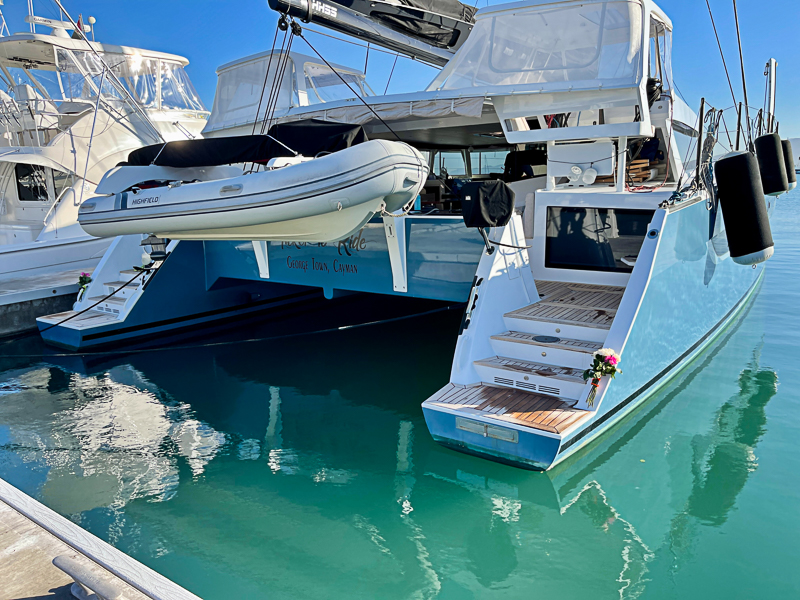

On April 21st, we sailed to La Ventana where we dropped anchor and enjoyed a day on the hook to decompress from the city and the stress of provisioning and preparing. We spent the day relaxing, enjoying the water and settling in as a traveling group of four. Since Amelia and Erik passaged with us from Hawaii to Alaska, the process of settling in was really the fun of reuniting with friends who are excellent travel companions.
La Ventana to San Benedicto was an easy 329 nautical miles.We departed La Ventana after the southern winds died and we hoped for some north winds. A leisurely departure around 9:30 am with only 6.5 k of wind speed, we motored a bit until the wind angle improved then we put up the mainsail, genoa and spinnaker staysail. Day one we only covered 88nm between 9 am and midnight. The second day we had better winds and covered 188nm which set us up for a lovely 7:40 am arrival on April 25th. Our trip to San Benedicto took a little over 46 hours with an average speed of 7.1k and a maximum speed of 14.8k. This was a great warm up for the crossing to the Marquesas.



The Revillegedo Islands are sometimes called the Galapagos of Mexico because they are remote, rarely visited and have plenty of sea life. We chose to stop here to scuba dive again (our third visit) and enjoy watching the giant manta rays and other wonders below.
Above water, San Benedicto is desolate, without growth and covered in a loose ash that can infuse the air and dirty the decks on windy days. Under the water, San Benedicto is filled with colorful fish, huge rock pinnacles, deep canyons, giant manta rays, schools of fish and plenty of sharks.
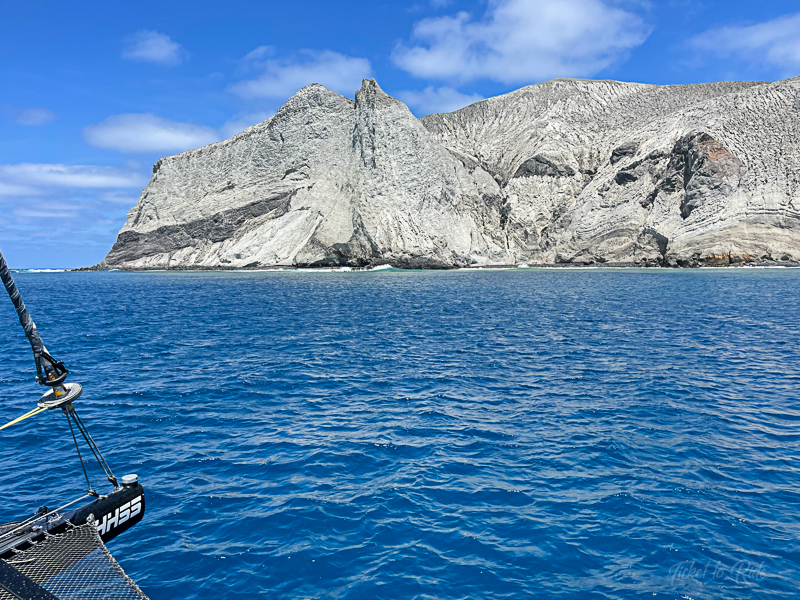

In the evening we turned on our underwater boat lights and watched the small fish gather. But soon larger fish and sharks arrived for some easy hunting. Then we were surprised that dolphins moved in and usurped the territory forcing the sharks to share the hunting ground….. We didn’t leave the lights on very long as we don’t want to alter the natural tendencies of the ocean dwellers. We did enjoy the show while the lights were shining though.
The ocean is a marvel of life and we seem to observe new behaviors or new things regardless of how much time we live on the water.
While we enjoyed San Benedicto, there was a little looming reminder that we had a long passage before us and we were all excited to begin. Our weather window arrived quickly and we departed on Thursday, April 28th at 11:20 am. The first day of we had steady winds between 8 and 16 knots and very calm seas. We managed a bit over 106 nm with an average speed of 8.9k. I remember thinking this trip would be a cakewalk if we kept those conditions.
Our first surprise arrived in the form of a land bird who joined us as we were leaving San Benedicto. We tried hard to shoo him back to San Benedicto and off to Socorro when we were passing that island. Alas, “Lenny” had other plans and he chose to turn in his Ticket To Ride with us.


Initially, Lenny was very brave, perhaps in shock, and would land on us or near us. Once I was lying down in my room and felt something near my face….. it was Lenny sitting next to me on Frank’s pillow! Cute as that sounds, Lenny was not house trained so we shooed him outside.
As animal lovers, we couldn’t bear to leave Lenny in need, so we began feeding and watering him regularly. Ironically, this made Lenny less willing to come near us. Soon we had a knowledge of his food preferences (he loved corn chips and cashew clusters) and we had taught him not to enter the salon but to stick to the outer parts of TTR!
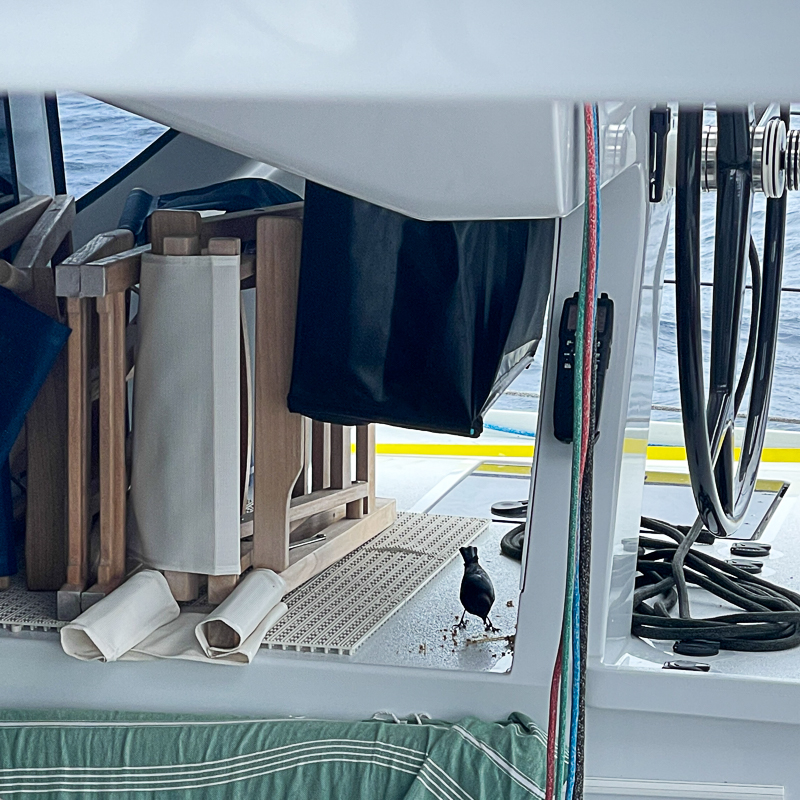

Training Lenny not to come inside TTR was very quick but also a little sad. The first evening, in an effort to train him, we closed the sliding doors while we ate dinner. Lenny kept flying up to the door to try to join us! Then he would walk along the sliding door peering in and making little flying hops to try to find an entrance. It was both comical and sad, but effective. Lenny rarely entered the salon after that evening even though we left the sliding doors open the remainder of the passage!
Lenny was not a fan of winches and would fly to the front of the boat or hide in the dinghy and sometimes fly off the boat whenever major sail changes occurred. When the noises of sail change ramped up, Lenny would fly away, then return shortly later. One the night of day six from San Benedicto, we had several sail changes and there was a bit of rain and wind. Apparently Lenny was pretty unsettled by all the noise and flew a little further than usual from TTR. But since he had disappeared and reappeared many times over the last days, we weren’t too worried.…
Until we didn’t hear any chirps all morning. On day seven, Lenny did not return. We were hoping he was just extra tired after a busy night of sail changes, but alas, Lenny never returned. We kept Lenny’s spot stocked with his favorite food for a day or two, just hoping he would surprise us and reappear. We really hope Lenny found a different boat where he is happily ensconced and being well fed. I don’t like to think of our little feathered friend fatigued and lost at sea.
Days and nights on passage are a collidescope of skies, ocean, sunsets, sunrises, naps, food, podcasts, music, stars, stars and more stars! After a few days, a loose routine sets in where we rotate night watches of three hours each, unless there is a weather concern, then we have two people on deck for six hours and they take turns up and sleeping. During the daylight hours, with four souls on board, it is easy to grab naps as needed because somehow all of us end up wanting to sleep at different times. This trip we changed watch hours so that we could have a variety of views; one person didn’t always have the sunrise or the deep dark hours around 2 am.
One interesting and slightly disconcerting aspect of this passage was time and time zones. As we traveled south and west, our location changed the timing of sunrise and sunset. Not very far into the passage, sunset was occurring around 8:45 instead of 7:15ish. And sunrise had become 5 am. This alteration of the sun in comparison to the Mexico time zone on our clocks made it necessary to alter our shifts so we were actually covering the hours of darkness. We had to determine the correct time in Nuku Hiva so we could adjust our internal rhythms as well as our clocks and shift schedule. This passage, the change in time zone felt more drastic than when we sailed from Hawaii to Alaska.
Turns out, Nuku Hiva time is actually 3.5 hours behind Mexico time. I didn’t even know there were places that altered their clocks by 30 minutes; I thought it was always by the hour. Though upon reflection, the need to adjust incrementally makes complete sense.
The one consistent event on TTR is dinner. We always make dinner a satisfying meal that all of us eat together at the table. The autopilot is on but we remain aware of conditions as we enjoy a meal together. This is a great time to discuss concerns, recap the day and strategize based on weather information. This is also a time for us to adjust sails in preparation for night watches before dark sets in. It is MUCH easier to adjust sails in the light and perhaps even be a bit conservative on our sail plan, rather than throw the dice and have to make major adjustments in the dark when conditions have become a little spicy.
As mentioned in the Hawaii to Alaska blog, we eat really well on Ticket To Ride! If you are interested, at the end of this post I have listed our dinners during this passage.
Fishing, or as I call it “dragging,” is definitely hit or miss on TTR. Often we are sailing so quickly our lures get frayed or we are too fast to hook up fish (9+ knots). But we still try. The first day we had our lures out, we sailed near a group of birds obviously diving into a fish-boil. Moments later one rod offered the “zing” of a fish on, though the pull was light and sporadic. We hopped into action, furling the headsail, heading to wind to slow the boat, etc.
Imagine our dismay when we realized a Booby Bird had snagged our line! We brought the bird in as gently as we could and found he had tangled a wing in our line. Thankfully, he allowed Frank and Erik to carefully remove the line – he didn’t even become aggressive. Really quickly the line was free but the bird chose to ride along with us for about 15 minutes while he was catching his breath. Perhaps Lenny gave him confidence that we were safe.
We spoke gently to the Booby and encouraged him to be well and fly back to his friends, which he did, without issue. Phew! Enough fishing for that day!!
Sunday as the sun was descending into the horizon, the starboard side fishing rod zinged to life. Amelia and I handled sail furling while Frank and Erik pretended to be participants in The Deadliest Catch! Actually, they didn’t pretend anything, but they did land a beautiful Mahi! Yum!


Calm passages are a good time to catch up on some “Boat Love,” as we refer to many boat jobs. The skies were clear, the seas were calm and we took a moment for some TTR maintenance. I polished a little bright work while Frank waxed some painted surfaces. Not wanting his shoulders overexposed to the sun which was growing more powerful as our trajectory moved us closer to the equator, Frank donned a shirt for protection. However, the combination of sun and effort soon had our captain’s temperature rising; so in the best way possible, Frank made a costume adjustment and rocked his Britney Spears look!

Erik received the award for strangest event during this passage. One night while on watch, he saw a huge object fly across the sky. He still can’t figure out if it was a meteor, a UFO, a comet or something else. Of course we couldn’t access the news to see if anything was reported but Erik did manage to snap this photo which he says doesn’t begin to do the event justice.
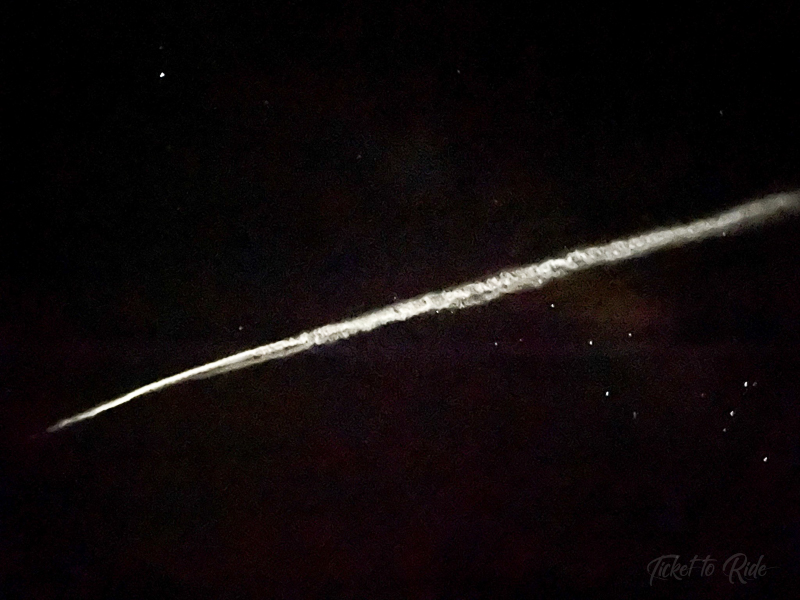
I find it truly amazing how vast and small the ocean can be. Days on end we will see no one, hear no chatter on the VHF and wonder if the world has disappeared while we were in no mans land. But sometimes it is crazy to actually see another boat come very close to you when there is so much space in the ocean that you could easily pass someone nearby but not within eyesight.
Our friends on s/v Migration, Bruce and Alene, had left a different Revelligedo Island than we did and upped anchor only 45 minutes before us. Bruce and Alene were about 200 nm further along than we were but we hoped to somehow meet in the middle of the Pacific and say hello.
We kept in touch via satellite messages and hoped we would catch them. Late one evening, the VHF sounded a familiar call, “Ticket to Ride, Ticket to Ride, Migration here.” We jumped for the radio, galvanized by the voice of our friends, only to realize that our VHF was not transmitting well, or maybe not at all! It was very frustrating to hear Migration call and not be able to respond.
We were not within eyesight, but we could have been within earshot!
Frank and Erik addressed the VHF issue and learned that an essential component had failed. Luckily Frank attached our back up, handheld VHF directly to the mast antenna making it possible to use the radio. Our next visitor will get to bring us the part necessary to make our boat VHF operational.
Just a few days later we spotted a light on the horizon during the early morning darkness. As the run rose, we caught up to s/v Pablo, a monohull heading to Nuku Hiva with five souls on board. Amelia grabbed the camera and took some lovely pictures which she shared with that family once we were all in Taiohae Bay.
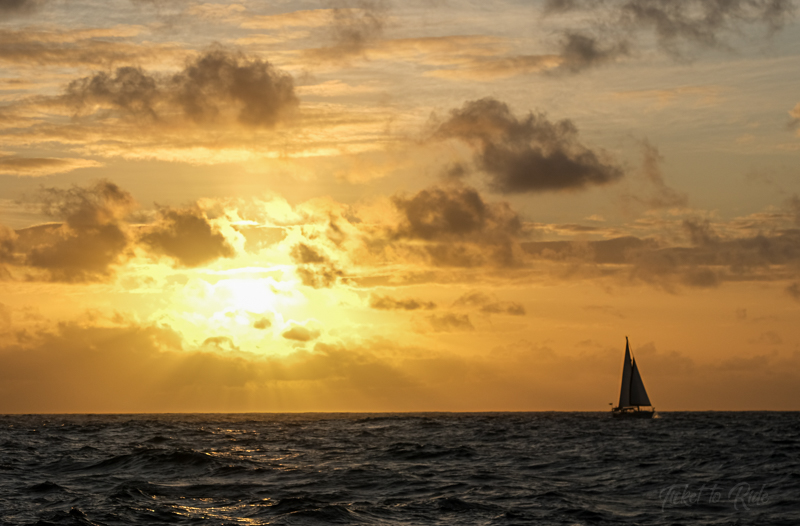
I am not one for “Bucket Lists” but I really wanted to swim in the middle of the Pacific Ocean, and I really, really wanted to swim at the equator. There is an area known as the ITCZ, Inter-Tropical Convergence Zone, where the weather can be dicy or dead calm; stormy and squally or smooth as glass without a ripple of wind. The ITCZ is a moving area that expands and contracts based on weather, so it is a moving target that sailors try to move through at its most narrow point.
We were blessed with a calm passage through a narrow ITCZ which allowed us to SWIM on Wednesday, May 4th. First we floated a long line off the stern of TTR as a grab line in case of a current or boat movement. Next, Frank and Amelia chose to jump from the helm station roof, while Erik and I donned our mask and fins. On the count of three, the team jumped into the Pacific Ocean!!
Erik was immediately approached by a HUGE marlin – we estimate he was 8-10 feet without his bill! The marlin approached to within about 12 feet of Erik. When I spotted the marlin, he had his mouth open and it looked like he was determining if we were all tasty nuggets dropped from above. Thankfully he decided we weren’t chum and with one slight flick of his tale, the marlin disappeared into the depths.
I will never forget the beauty and power of the moment I saw that marlin. He was a shiny, sleek sliver-blue suspended in a perfectly clear, dark blue sea. The only thing I can reference to describe him would be a glass sphere, like one on a dest, that has a marlin suspended in translucent blue glass that reflects against his armor-like exterior.
What an experience!
I am beginning to think Bucket Lists might be as powerful as positive thinking since I was also gifted with the opportunity to swim at the Equator!! Now that was icing on my wishes since my true hope had been to swim at the equator; but often the weather isn’t cooperative or a boat crosses during darkness.


Not TTR! At 10:38 am on May 7th, the chart plotter showed 0 00.000’ We were ON THE EQUATOR!
We pointed our bows to span the equator and allowed Jude, the auto pilot, the direct our course while we celebrated and swam!
Tradition demands a celebration/initiation of sailors who cross the equator for the first time. Post ceremony, a sailor looses his status as a Pollywog and becomes a Shellback. At its essence, this means a person is no longer green or untried but rather has earned his stripes as a sailor. Celebrations and hazing are often hand in hand with the initiation and as the only shellback on board, Amelia had control of the initiation for Frank, Erik and me….
Fortunately Amelia is very playful but doesn’t have a mean bone in her body, so I knew fun would be had with just a smidge of hazing. Having said that, our playtime becoming Shellbacks was so fun that it deserves its own blog. Check back for our next piece with all the details and photos!
Many people told us they found a .5 to 2.0 knot favorable current beginning anywhere from 3 degrees N of the equator all the way to Taiohae Bay on Nuku Hiva. We knew Nuku Hiva was only a few days away yet we had only experienced unfavorable currents of up to 1.5 knots. If we could find that positive current, our travel time could be reduced by at least one full day.
Alas, no such luck! We only saw negative current or neutral current throughout our passage. Still, our arrival time was anticipated to be sometime on May 11th which would mean our total travel time since leaving La Ventana was only 16 days. Complaining is completely unwarranted.
May 10th arrived bright and sunny with just a few wispy clouds – perfect for celebrating Erik’s 40th birthday! Amelia had masterminded a fun celebration and while in La Paz we had procured “things” to make this birthday a memorable one.
Ironically, several times during the passage, Erik had bemoaned not buying a piñata before leaving Mexico. Unbeknownst to him, Amelia had squirreled one away and it was the first step in Erik’s birthday celebration and gift hunt!
We had a great time watching Erik unravel Amelia’s clues for where to find his gifts. New clues and fun surprises were dispersed in the freezer, the dinghy, the mast line bag and even the bilge. Erik was a good sport and wore the piñata as a hat for much of the day. That evening we celebrated with burgers, homemade buns, yummy veggies and blondies for dessert dessert which we topped it with ice cream we had hidden in the freezer for this special occasion.





Throughout the trip, I tried to have some little special things to help keep the crew happy and make sure spirits were lifted if needed. At the equator crossing, Frank, Erik and Amelia received t-shirts from La Paz. At the 1/2 way point we had a pretty fancy dinner of pork tenderloin in a brown sauce with green beans and rice followed by brownies. When we reached 500 nm remaining, I brought out dark chocolate covered cherries straight from Michigan.
None of those things are really important, but they do make life aboard a bit more fun.
The day after Erik’s birthday we could clearly see Nuku Hiva in the dawn light. A small group of dolphins acknowledged us by swimming past us as we approached Taiohae Bay. The water washing against and away from the mighty elevation of Nuku Hiva was sharp and tumultuous as we jetted in under main and reacher. By 10:20 am on May 11, 2022, 13 days and 23 hours after leaving San Benedicto, we had set our anchor in French Polynesia. We had completed our passage to French Polynesia and achieved a milestone! Without regard for the early hour, we broke out the bubbly to celebrate a successful and excellent trip across the Pacific Ocean.

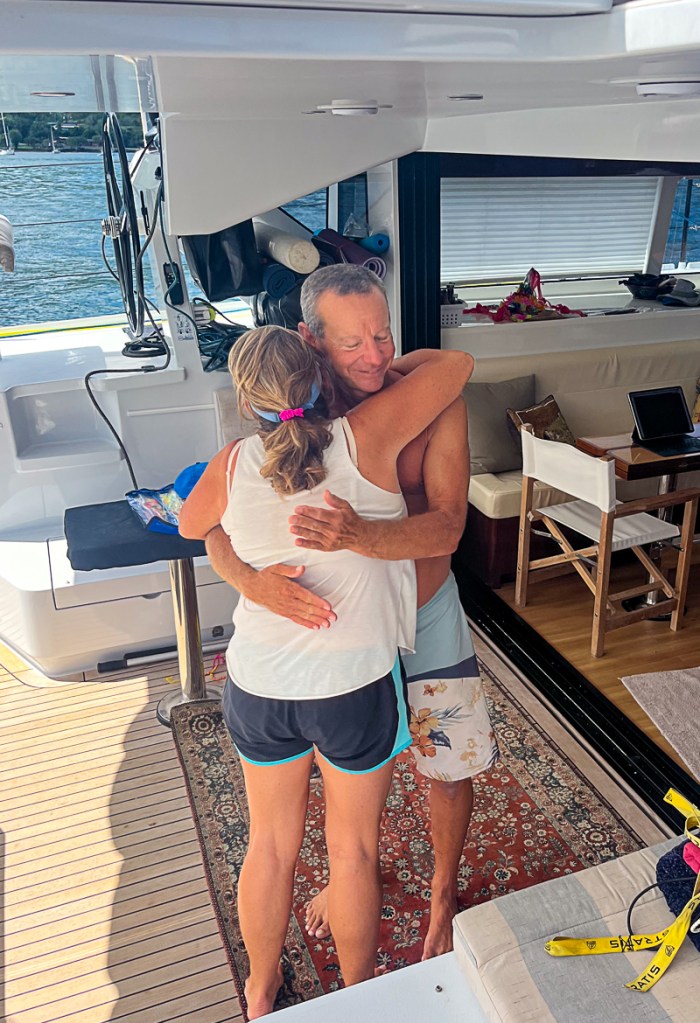
It bears stating that our passage was truly a blessed one! We saw storms on the horizon that looked destined to inundate us with wind and rain, yet they all passed before or behind us or dissipated before we reached them. At times it felt like the Red Sea was parting before us! TTR felt like she was enclosed in a special space of protection as we encountered very few weather or sea surprises.

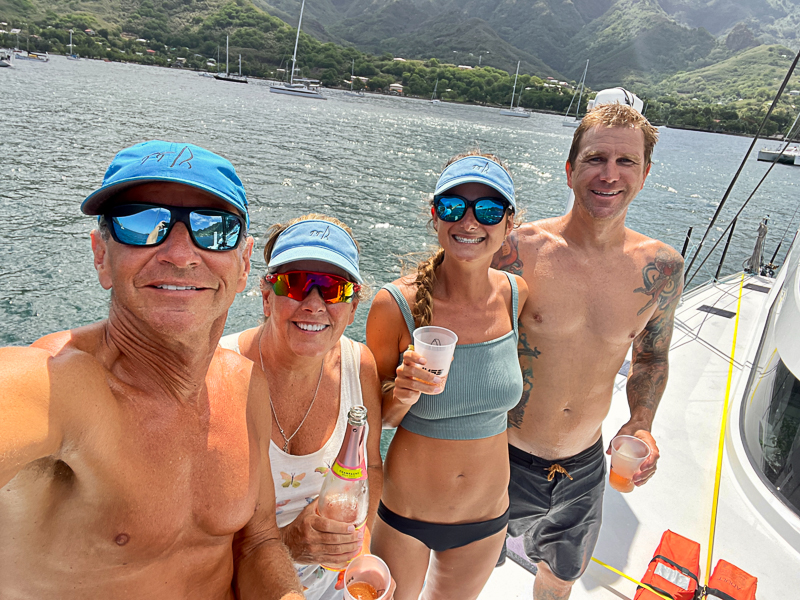
Our travel time was quick and our breakages nearly non-existent. The only problems we had were: 1. the VHF Box failed and needs to be replace, but Frank rigged up a temporary fix. 2. Our IridiumGo antenna was knocked by the leach of a sail when the wind flogged but while at the Rev’s, Frank went up the mast and installed a protective margarita mix bottle – hahaha, now our antenna is very happy. 3. When we arrived in Nuku Hiva, the anemometer at the top of the mast was loose and Erik took a ride to the top of the mast to tighten the loosened screws.
SAILING SYNOPSIS: This is a simplified table of our sailing, not a perfect representation of detailed sail changes and wind speeds or angles.
| Rev Islands to Nuku Hiva, FP on Ticket To Ride | TRUE WIND SPEED | TRUE WIND ANGLE | SAILS DEPLOYED | TOTAL 24 HOUR MILES |
| Day 1 | 13 | 114 | Main R1, drifter | 106 (13 hours) |
| Day 2 | 14 | 119 | Main R1, drifter | 212 |
| Day 3 | 13 | 170 | Drifter, genoa | 158 |
| Day 4 | 10 | 160 | Drifter at night, double headsails by day | 148 |
| Day 5 | 11 | 155 | Drifter only | 156 |
| Day 6 | 13 | 152 | Drifter only | 169 |
| Day 7 | 4-13 | 17-160 | Drifter 16 hours, 1 engine 8 hours | 145 |
| Day 8 | 16 | 65 | Main R2, genoa | 185 |
| Day 9 | 18 | 100 | Main R2, genoa | 231 |
| Day 10 | 14 | 105 | Main R2, genoa 12 hours, Main R1 w Reacher – 12 hours | 195 |
| Day 11 | 12 | 125 | Main R1 and reacher | 205 |
| Day 12 | 15 | 100 | Main R2, genoa 12 hours, Main R2, reacher 12 hours | 243 |
| Day 13 | 18 | 123 | Main R2 and reacher | 242 |
| Day 14 | 17 | 130 | Main R2 and reacher | |
Dinner on TTR is a “thang”
~Mykronos Aubergine Stew – veggies, including eggplant – yum.
~Grilled AK Halibut on a bed of mixed greens and avocado with sautéed poblano pepper, asperagus, onion, etc
~General Tsao’s Tofu with cilantro garnish
~Erik’s Chicken Noodle Soup for lunch on passage
~Chicken Tacos with homemade salsa: creamy cashew cilantro sauce
~Grilled Pork Chops, salad, rice
~Pasta Bolignaise and sauteed green beans with mushrooms
~Honor-da-veg Day: mixed veggies in Mexican seasoning in flour tortillas
~Pizza Night – homemade pizzas
~One-Pot Chicken pesto pasta (using homegrown basil!), E’s vegetable soup, roasted green beans with candies rosemary almonds
Caught the first fish – Mahi
~Cajun seared mahi, black coconut rice, salad
~Mahi mahi tostadas…. (Lenny’s last meal)
~Pork tenderloin, curried green beans, rice
~Cinco de Mayo! Chicken tostados
~Cold asian noodle salad with panko crusted tofu
~Equator Pasties (meat pies) and blueberry pie
~Mahi, salad, rice
~Breakfast for dinner – eggs and waffles
~Birthday burgers, buns and fried potatoes, blondies with ice cream as birthday dessert
Phew! This was a long blog. Thanks for reading ALL of that. I hope this gives you some insight into our passage and how our time is spent while at sea. Please send us a comment if you have questions, and keep an eye out for our really fun pollywog to shellback ceremony!
P.S. I didn’t have enough internet to preview this post, please forgive poor formatting or mistakes. 🙂

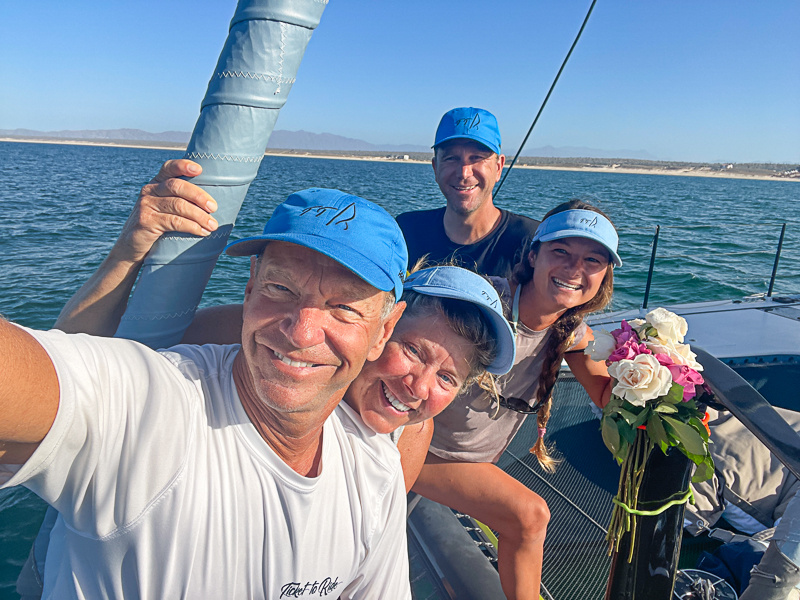
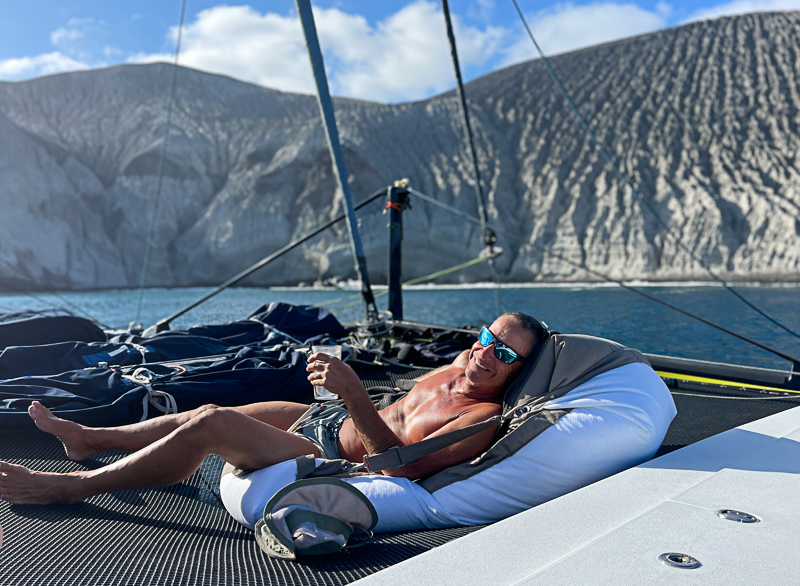


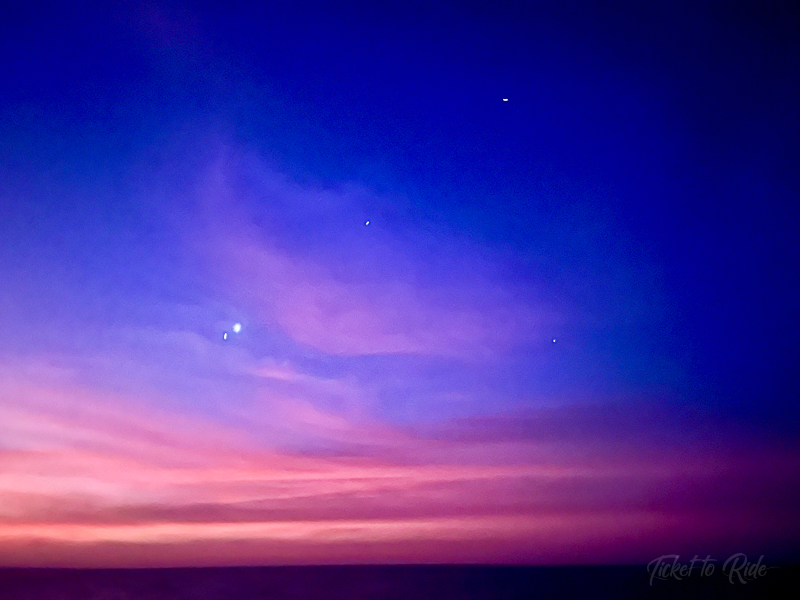

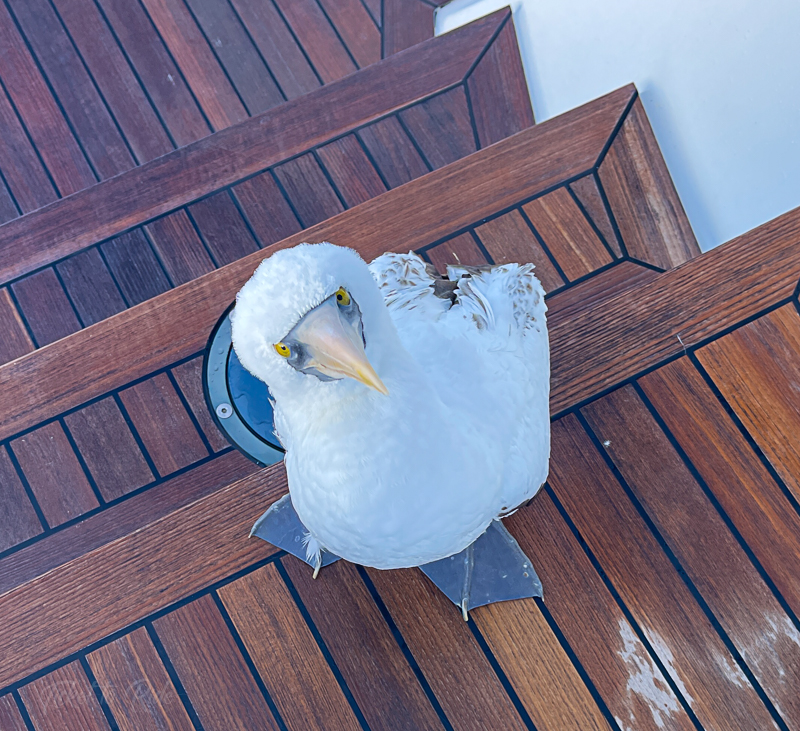


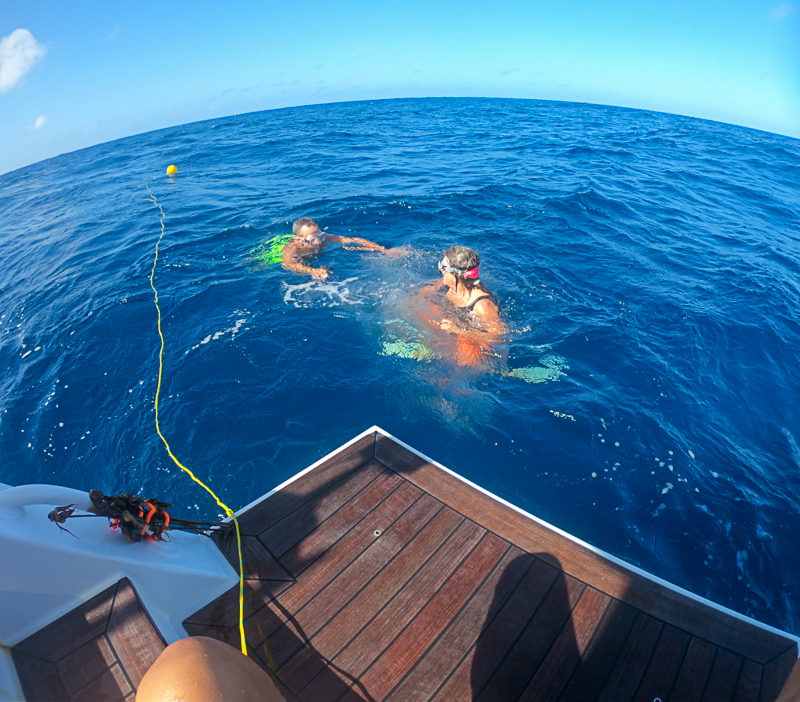
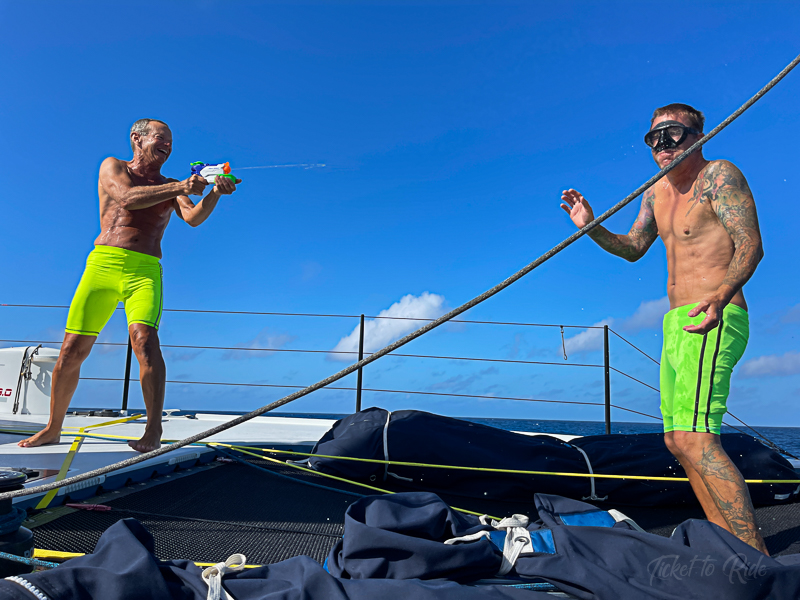
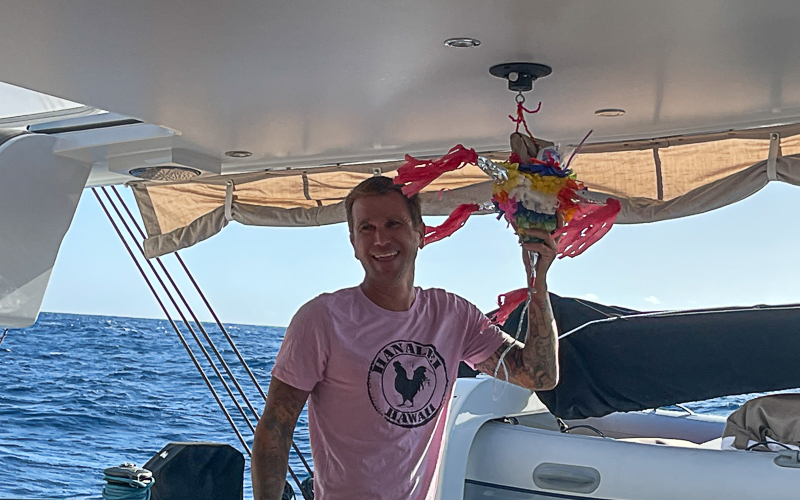
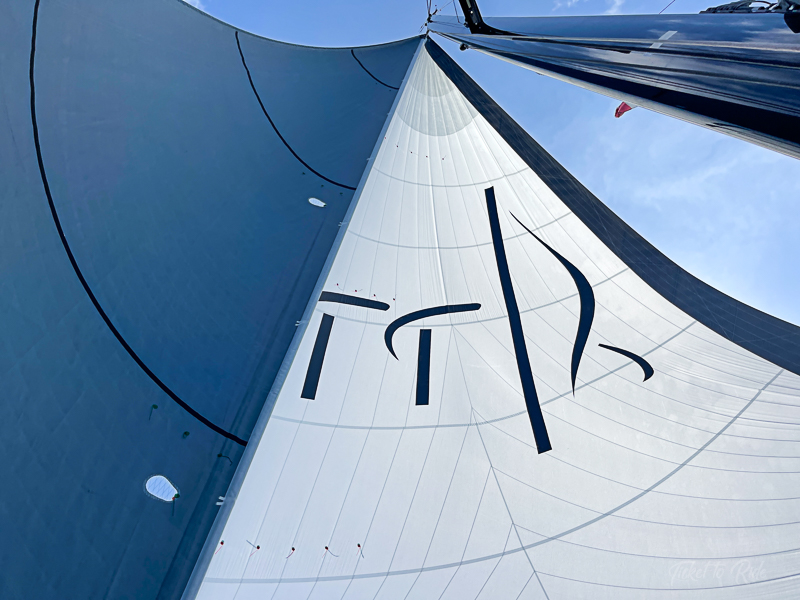
Happy to read you had a good and safe passage to French Polynesia.
Enjoy these wonderful islands and people. I like the way you make the passage fun.
Swimming on the equator made it onto my list.
All the best
LikeLike
Looks like an absolutely terrific passage – congratulations! Departing LA for Hawaii on July 16…
LikeLike
Not a big boater but really enjoyed reading your crossing. What a fun “safe” trip
LikeLiked by 1 person
Well thank you for reading the blog – especially if you aren’t into boating.
LikeLike